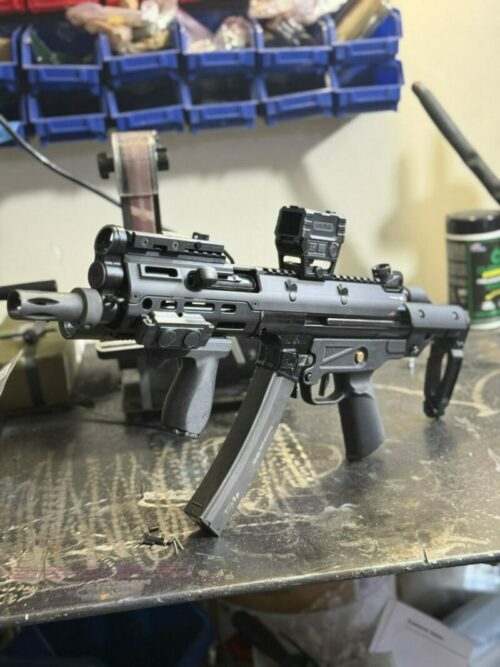This MP5 Super Safety Troubleshooting guide focuses on MP5 builds chambered in 9mm, such as the MP5 Leber V2. Although similar principles apply to other models, steps may differ slightly. Note: All products should be installed and tested by a qualified gunsmith.
Quick Overview
This guide provides structured troubleshooting steps for MP5 Leber V2 builds using the Super Safety system. Each section builds on the previous one, so follow them in order:
- Lower (disassembled) troubleshooting
- Assembled — Dry fire troubleshooting
- Upper (disassembled) troubleshooting
- Assembled — Live fire troubleshooting
MP5 Leber V2
Leber V2 Disassembled — Lower Troubleshooting
Before beginning any lower-receiver troubleshooting, confirm the following baseline conditions. Proper setup helps ensure consistent, reliable results throughout the process.
- Use mil-spec AR-15 parts in your lower.
- Load and test exclusively with 124gr NATO 9mm ammunition. Avoid 115gr, 147gr, +P, or subsonic loads during diagnostics.
- Do not use M16 FCG parts or non-standard components during initial testing.
Issue: Trigger pull feels very heavy in Super Safety
Solution: Begin by lightly sanding the rounded corner of the trigger using 220-grit sandpaper. Work slowly and maintain the rounded shape. Afterward, polish the same area with 320- and 400-grit paper to smooth the surface without removing additional material. The goal is to create a clean surface finish while preserving geometry.
Issue: Trigger does not function in Super Safety (won’t pull or won’t release hammer)
Solution 1: Try moving the Super Safety slightly around its middle position. If the trigger remains blocked, the tail of the trigger may be too wide, or the safety detent hole may be slightly misaligned.
Solution 2: As an alternative, lightly sand the rounded corner of the trigger with 220-grit paper. Maintain the rounded profile and repeat small adjustments as needed. Finally, polish the surface once the function test passes.
Issue: Super Safety cam jumps positions during checks or firing
- Solution 1: Confirm the safety detent is properly rounded and hasn’t flattened over time.
- Solution 2: Examine the safety detent spring for bends or pinch points. Additionally, make sure there is distinct tactile feedback between positions. If pressure feels weak, add a small shim under the detent or spring to increase compression. In rare cases, you may need to reduce pressure slightly by trimming a single coil.
- Solution 3: When all else fails, the cam may be out of specification—contact the manufacturer for inspection.
Issue: Trigger does not reset when lever is fully back
- Solution 1: Verify the safety cam is centered. The middle position is the proper Super Safety reset point.
- Solution 2: If reset still fails, the trigger may be over-cut. In this case, contact the vendor for a replacement or evaluation.
Issue: Trigger and hammer pins “walk out”
Solution: Always install Anti-Walk Pins when using Super Safety kits. However, avoid anti-rotation pins, which can cause additional binding issues.
Issue: Safe position does not engage properly
Solution: The trigger is likely cut incorrectly or the installation is incomplete. Restart the installation process carefully, and if the issue continues, reach out to a qualified gunsmith or vendor support.
MP5 Leber V2 Assembled — Dry Fire Troubleshooting
Once lower troubleshooting steps are complete, proceed to these dry-fire tests. These checks help confirm smooth mechanical interaction before live ammunition is used.
Issue: Bolt carrier binds or sticks about three-quarters rear travel
- Solution 1: If using an unrounded hammer, install the TPU buffer tube or round the hammer tip with an approved jig so the bolt glides over it smoothly. Alternatively, consider using a hammer specifically designed for the Leber V2 and Super Safety system to eliminate the need for a buffer tube.
- Solution 2: Inspect the ejector lever for wobble. On certain lowers (for example, ARMP5v3 Rev1), tightening the ejector-lever nut can eliminate lateral movement. Lightly polish any sharp or raised corners on the lever to ensure free bolt travel.
- Solution 3 (rare): In unusual cases, the top surface of the lever may be too tall. Slightly lowering this surface may resolve the issue, though this step is not typically required.
- Solution 4: If binding persists, contact technical support for guidance.
Issue: Trigger is “dead” after one round — acts like safe or fails to reset
- Solution 1: Verify that the hammer spring is correctly oriented. A reversed spring can cause hammer follow or reset failure.
- Solution 2: Check whether the hammer is resetting properly. If it fails to hold, swap the hammer or disconnector one at a time to isolate the defective component.
- Solution 3: For Geissele assemblies, confirm that the hammer tip is not excessively rounded per vendor guidelines.
Issue: Bolt will not close fully into battery
- Solution 1: Always perform an “HK slap” rather than easing the charging handle forward. The momentum assists full chambering.
- Solution 2: Re-inspect lower and upper fitment—check bolt gap, slip trip clearance, carrier movement, and recoil spring orientation. Occasionally, an out-of-spec ejector lever can restrict forward travel.
- Solution 3: If the issue occurs only with fully loaded 30-round magazines, test with 29 rounds. Persistent problems may indicate a mag-catch height issue.
Issue: Lower exhibits noticeable “play”
Solution: Because MP5 Leber V2 tolerances vary, a small amount of slack is common. To reduce movement, add thin foam pads or shims between the lower and stock, brace, or endcap until fitment feels secure.
MP5 Leber V2 Disassembled — Upper Troubleshooting
receiver problems typically originate from OEM manufacturing variances or denial-block interference. If a defect appears factory-related, pursue an RMA before attempting modification.
Issue: Slip trip doesn’t slide smoothly past the rear denial block
Solution: Gently adjust the slip trip itself by moving it side to side and up and down until it clears the denial block completely. Never modify the denial block.
Issue: Lower will not fully seat on an AP5-P made after early 2025
Solution: Confirm that your Leber V2 is the latest model revision. Contact the vendor if uncertain.
MP5 Leber V2 Assembled — Live Fire Troubleshooting
After completing lower and upper diagnostics, move on to live-fire troubleshooting. These steps identify functional issues under recoil and cycling stress.
Issue: Fewer than five rounds fire before a light primer strike or hammer follow
- Solution 1: Try multiple ammo brands. Some primers are harder or weaker than others. Always start with 124gr NATO ammunition for consistent results.
- Solution 2: Replace the hammer spring with an extra-power spring such as the Wolff 30095. This often resolves light-strike issues.
- Solution 3: If problems persist, contact the vendor for further support.
Issue: Failure to extract or eject (stovepipe or dual feed)
- Solution 1: The most common cause is underpowered ammunition. Therefore, always use 124gr NATO for baseline testing and avoid subsonic loads.
- Solution 2: Inspect the ejector lever for side wobble or surface damage. It should move freely with firm spring pressure.
- Solution 3: On K-models—especially suppressed setups—adjust the locking-piece angle (80°, 90°, or 100°) as needed to balance cyclic rate.
- Solution 4: As a last resort, replace the extractor spring, extractor, and finally the ejector lever. OEM H&K parts are preferred for longevity.
Issue: Lever breaks within the first 100 rounds
- Solution 1: Review the Dry-Fire section to ensure proper setup and alignment.
- Solution 2: If metal hardening appears incomplete, contact the vendor for warranty replacement.
Issue: Rate of fire too high (Full-size over 950 RPM, K-size over 1200 RPM)
- Solution 1: Confirm you’re not using +P or high-velocity ammunition. Then, test unsuppressed with 124gr NATO loads for a consistent baseline.
- Solution 2: Adjust with a lower-degree locking piece to reduce bolt velocity.
- Full-size: 100° for most configurations.
- K-size: 80° (suppressed), 90° (mixed), 100° (unsuppressed).
- SD: 115°–120° recommended.
Issue: Failure to feed
- Solution 1: Start troubleshooting with genuine H&K magazines to remove variables.
- Solution 2: Use round-nose ammunition; flat-nose designs often cause feeding inconsistencies.
- Solution 3: Examine the mag catch for height and alignment. Replace with an HK-brand catch if necessary.
Issue: Slip trip breaks prematurely (fewer than 5,000 rounds)
- Solution 1: Excessive bolt velocity is usually the cause. Accordingly, review the rate-of-fire section above.
- Solution 2: Inspect the inside of the stock, brace, or endcap for impact marks from the slip trip. If marks are present, add clearance or install a buffer tube.
- Solution 3: Vendors often replace one prematurely-failed slip trip under warranty—contact support.
If you have completed all steps and the issue remains, reach out to vendor support or a qualified gunsmith for detailed inspection.
Legal & Safety Notice
Important: This document is for diagnostic reference only. It is not an installation guide. All work should be performed by a qualified gunsmith. Always follow local, state, and federal firearm laws. Improper modification may result in unsafe operation.
Here are some videos from trusted sources, click the blue link “name” and you will be redirected to that source.
Check out our friend and sponsored YouTube channel POORBOY ARMS. They have a great video on how to maintain, repair, and troubleshoot your MP5 Leber V2 or any MP5 lower!
MP5 Leber V2 field strip disassembly/reassemble
For official MP5 specifications and reference materials, visit the Heckler & Koch official website.
For more technical support, visit our Support Center or read the Leber V2 Slip Trip product guide.

Credit To AS Designs and the IT department @BSsquirts for whipping up this bad ass guide.


